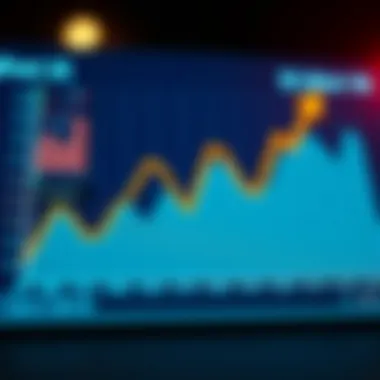Understanding Bank Conversion Rates for Smart Finance


Intro
In the world of finance, understanding how bank conversion rates work is paramount for anyone involved in currency exchange. Every time you convert one currency to another, from pounds to dollars or yen to euros, there is a rate applied that can significantly affect your financial decisions. This article serves as a roadmap for those keen to navigate the intricate maze of bank conversion rates, shedding light on their calculation, relevance, and optimization strategies.
Getting to grips with these rates can save you considerable money, especially for individuals investing or trading internationally. After all, as the saying goes, "A penny saved is a penny earned." Whether you’re a seasoned investor or someone handling travel expenses, knowing the ins and outs of currency conversion is vital. Let’s dive deeper into this complex yet fascinating topic.
Key Terms and Definitions
Understanding the lingo is half the battle won. Here’s a breakdown of essential terms that will help you get a firm grasp on bank conversion rates.
Investment Terminology
- Conversion Rate: This is the rate at which one currency can be exchanged for another. For example, if the conversion rate from USD to EUR is 0.85, this means that for every dollar, you get 0.85 euros.
- Exchange Rate: While similar to conversion rates, exchange rates can often differ due to market fluctuations and may vary between banks.
- Spread: The difference between the buying and selling rates of currency. Banks usually charge a spread as their profit.
- Market Rate: This reflects the current value of a currency in the global market, influenced by economic conditions, interest rates, and political stability.
Detailed Explanations
When dealing with conversion rates, several factors come into play, such as global interest rates, inflation rates, and even economic stability. Here’s how these elements impact your transactions:
- Inflation: A country with a low inflation rate tends to see an appreciation in its currency's value. This means that purchasing power increases relative to other currencies.
- Interest Rates: High-interest rates offer lenders a higher return relative to other countries. As a result, higher interest rates attract foreign capital and cause the exchange rate to rise.
Understanding these terms and factors allows you to be more informed when making financial decisions regarding currency transactions.
Expert Insights
To enrich your understanding, let’s turn to some expert insights that illuminate the nuances of bank conversion rates.
Investment Strategies
When considering currency exchange, a few strategies should make it to your toolkit:
- Stay Informed: Monitor economic news and forecasts. Websites such as Investopedia, Bloomberg, and Reuters provide valuable insights.
- Use a Multi-Currency Account: This allows you to hold different currencies, better manage conversion rates, and potentially save on conversion fees.
- Hedge Your Currency Risk: If you're looking to invest in foreign assets, consider products like currency futures to protect against unfavorable exchange rate movements.


Market Trends Analysis
Recognizing trends in bank conversion rates can offer significant advantages:
- Historical Patterns: Analyzing past exchange rates can help predict future movements. Review data from institutions like The World Bank to spot trends.
- Global Events: Major events, such as elections or economic crises, can cause volatility in the market. Being aware of these can prepare you for potential rate shifts.
Understanding Bank Conversion Rates
Bank conversion rates hold a pivotal role in the financial landscape, especially for those engaged in international transactions. Understanding these rates is not just important for finance professionals, but also for anyone who might be dealing in foreign currencies. Grasping how bank conversion rates work can lead to more informed decisions, better financial strategies, and optimized transactions.
Definition of Bank Conversion Rates
In simple terms, bank conversion rates are the rates at which a bank converts one currency into another. This conversion typically occurs when an individual or business engages in transactions that involve international currencies, such as buying goods or services abroad or making investments in foreign stock markets. The conversion rate determines how much of the target currency a person will receive in exchange for their original currency.
When you sell a product online to a customer from another country or if you're traveling overseas, understanding the conversion rates can help you know how far your money can stretch. For instance, if you convert US dollars to euros, the conversion rate will dictate how many euros you receive in exchange for a specific amount of dollars. This understanding is crucial because fluctuating rates can lead to unexpected costs or savings.
Importance of Conversion Rates in Banking
Conversion rates are a cornerstone of banking operations, especially in global transactions. Without them, the flow of international trade would come to a standstill. Here’s why conversion rates matter:
- Financial Planning: For both individuals and businesses, knowing conversion rates is essential for budgeting. If you're traveling to a country with a different currency, awareness of the conversion rates can help you plan your finances better.
- Competitive Edge: Businesses that trade internationally benefit from understanding conversion rates to set competitive prices. If they can minimize currency conversion costs, they can offer more attractive prices to customers.
- Investment Decisions: Investors utilize conversion rates to assess their potential returns when investing in foreign markets. A favorable conversion rate can enhance returns, while an unfavorable one can diminish them.
In short, conversion rates are not merely numbers; they influence the very fabric of banking and investment landscapes.
How Conversion Rates Impact Transactions
Conversion rates can significantly affect transactions in various ways:
- Transaction Costs: When converting currencies, banks often add a markup to the rate. This means the rate you see is not the exact rate you get, which can lead to unexpected costs.
- Timing: The forex market is volatile, with rates fluctuating constantly. Timing a currency exchange can make a substantial difference in costs. Someone who converts their dollars to pounds during a favorable exchange rate will benefit, whereas the opposite can lead to losses.
- Market Ranges: Rates vary from bank to bank and across different platforms. Some banks might offer better rates than others, emphasizing the need for shoppers and investors to shop around before making a conversion.
- Transaction Speed: The time it takes for a conversion to process can vary based on the type of transaction. This can affect immediate decisions, especially in time-sensitive investments.
"Understanding the nuances of conversion rates can mean the difference between a profitable deal and a significant loss."
The Mechanics of Conversion


Understanding the mechanics behind bank conversion rates is essential for anyone looking to engage in international transactions or investments across various currencies. This section outlines how banks establish conversion rates, the influence of central banks, and core factors that impact these rates. These elements not only reflect the health of economies but also serve as critical indicators of financial decision-making. Being informed about the mechanics can help individuals make smarter choices when navigating currency exchanges.
How Banks Set Conversion Rates
Banks play a significant role in determining the rates at which currencies are converted. Unlike fixed rates, these rates are generally influenced by both market forces and institutional policies. At a basic level, banks monitor supply and demand for currencies to make real-time adjustments. If there's a sudden influx of travelers to Europe, for instance, the increased demand for euros could cause the euro's value to rise relative to the dollar.
Moreover, each bank may have its own way of calculating conversion rates. While many banks base their rates on the interbank market rates—what banks offer each other—additional factors like operational costs and profit margins play a part too. This often leads to a slight difference from the market rate available online. Ultimately, it’s crucial to shop around and be aware that rates can vary significantly from one bank to another.
Role of Central Banks in Rate Determination
Central banks are the backbone of a country’s monetary policy and have a huge say in how conversion rates are set. They manage national currency and control inflation, which can directly affect conversion rates. For instance, if a central bank implements a policy to increase money supply, it could cause inflation to rise, prompting a decrease in the value of the currency.
Their influence extends to interventions in currency markets as well. Central banks may decide to buy or sell currency to stabilize or support the value of their national currency. In such cases, the market can be shocked into adjusting conversion rates almost immediately based on the perceived stability of the currency in question. This makes central banks a key player in the mechanics of conversion rates.
Factors Influencing Exchange Rates
Understanding the factors that affect exchange rates can empower individuals to make better financial choices.
Inflation Rates
Inflation rates indicate how quickly a general increase in prices is happening in an economy. When inflation is low, that usually has a positive effect on a currency’s value, making it stronger when compared to other currencies. Conversely, high inflation rates can erode a currency's value.
One key characteristic of inflation rates is their direct correlation with purchasing power. As prices rise, the value of money decreases, which is often detrimental to long-term investments in that currency. This makes the analysis of inflation rates crucial for anyone considering foreign investments. Keeping an eye on these rates helps in making informed decisions that align with mission-critical goals.
Interest Rates
Interest rates significantly affect bank conversion rates. When central banks raise interest rates, it often attracts foreign capital, leading to an appreciation of the currency. This can be observed during a period when many investors are vieing for the highest returns on their investments.
Interest rates are appealing because they provide a straightforward way to predict currency trends. Higher interest rates generally mean that investors are more likely to invest in that country's currency, thus driving up demand and pushing up conversion rates. However, the downside comes in the form of increased borrowing costs for businesses and consumers alike, which can impact overall economic growth.
Political Stability
Political stability is another fundamental factor influencing exchange rates. A stable government creates a more favorable environment for business operations and investments, which in turn strengthens a currency. Investors often prefer to put their money in politically stable countries, valuing the reduced risk.


The unique feature of political stability is its long-term impact on national currency value. Political turmoil, on the other hand, can lead to rapid depreciation. Consider how any instability in a country can chase away investment, creating a fear of loss among investors. This shows why analyzing a nation’s political climate is key in understanding its currency's potential.
In summary, grasping the mechanics of conversion, including how banks set rates, the central banks' role, and the influences of inflation, interest rates, and political factors, lays down a solid foundation for financial decisions involving currency exchange.
Calculating Conversion Rates
Understanding how to calculate conversion rates is essential for anyone engaging in currency exchange, whether for travel, investment, or business transactions. The importance of accurate conversion rate calculations cannot be overstated. Misinformation in this complex area can lead to losses or unfavorable transaction outcomes. In this guide, we’ll explore various methods for calculating conversion rates, providing you with the knowledge to navigate these financial waters safely.
Understanding the Calculation Process
Calculating conversion rates essentially involves taking the value of one currency and converting it to another. However, it's not just a simple multiplication. You need to understand the rates being used and any fees that might be applied. Currency pairs, like USD to EUR, are typically quoted with one currency expressed relative to the other, often leading to confusion.
Here's a breakdown of the basic calculation process:
- Identify the Currency Pair: Know which currencies you are converting between.
- Research the Current Exchange Rate: This can be found on various financial news sites or through bank websites.
- Account for Fees: Banks and currency exchange services often charge a fee, which can significantly affect the final amount received.
It's like cooking a recipe; if you miss out on an ingredient, your dish may not turn out as expected. In this case, a missed fee is like leaving out salt—you wouldn’t want that!
Using Online Conversion Tools
In today's digital age, online conversion tools have become quite handy for quick calculations. Websites like XE.com or OANDA provide instant access to live exchange rates and can perform calculations on-the-fly. With these tools, you simply enter the amount you wish to convert and select your currencies to see the current rate.
However, while convenient, it’s essential to keep these points in mind:
- Check the Rate Source: Some tools may reflect outdated rates, which can lead to errors in calculations.
- Beware of Hidden Fees: Always read the fine print; some platforms might advertise no fees but incorporate costs into the conversion rate.
Despite their conveniences, these tools aren't foolproof. It’s still wise to cross-reference with your bank's rates, just to be on the safe side.
Manual Calculation Techniques
For those who prefer a hands-on approach, calculating conversion rates manually can be insightful. While online tools are useful, there’s value in understanding the math behind it. To manually calculate a conversion:
- Find the Current Exchange Rate: This can often be obtained through a financial institution or an economic news site.
- Perform the Calculation: Multiply the amount of the first currency by the exchange rate. For example, if converting 100 USD to EUR at a rate of 0.85: 100 * 0.85 = 85 EUR.
- Adjust for Fees If Applicable: If your bank charges a 2% fee on foreign transactions, you would need to consider that.
The formula may look like this:
Final Amount = (Initial Amount * Exchange Rate) - Fees







